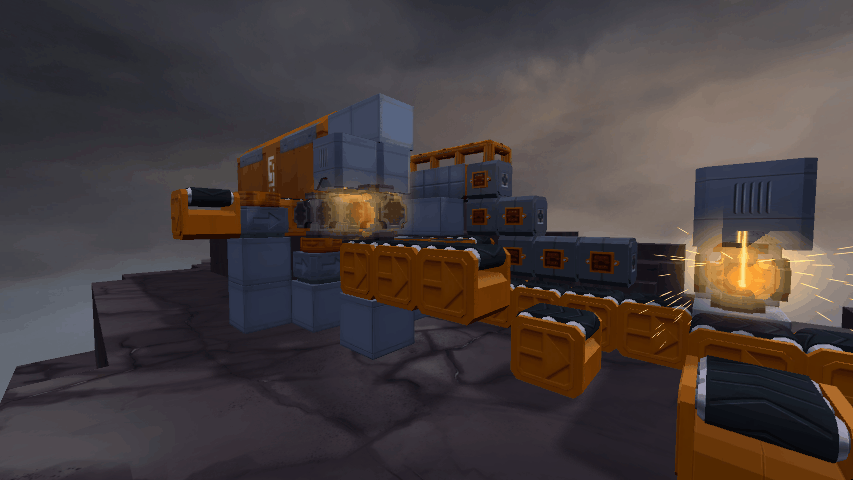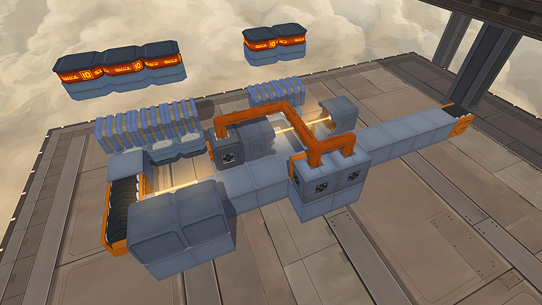

Infinifactory’s challenge instead lies in the design of individual mechanisms rather than the construction of an entire system each level starts with you taking a look at the input and ouput and mapping out a series of tasks that have to be done to make one match the other, and then building a series of mechanisms that will accomplish these tasks. Infinifactory is positively roomy by comparison – I’m 12 hours in and about two thirds of the way through the campaigns, and I’ve only just come across a level where I had to stretch to squeeze everything in. In SpaceChem you were slaved to that 2D grid which made transportation of the larger molecules downright hellish in places. This is a fair bit more freedom than SpaceChem gave you. You have an unlimited number of these blocks - which are perfectly happy floating in midair as long as there’s at least one block in the construction anchored to the ground - as well as the ability to fly anywhere in the level via jetpack, so the factory you can build is limited only by the selection of blocks you’ve unlocked and the total amount of space available in the level. To do this you have at your disposal a selection of factory blocks, starting with a basic conveyor belt and progressing through to welders, sensors, pusher blocks, rotator blocks and more. In Infinifactory the inputs take the form of (at the start of the game) a selection of one or more blocks that have to be stuck together into a certain configuration, or (later on) some big pre-built construction that has to be rebuilt into something new. Every puzzle in Infinifactory has you taking a set inputs and manipulating them to form a desired output, just like in SpaceChem. Oh okay, there are some important differences that go beyond the additional dimension. The manipulators can be given simple instructions – grab, drop, rotate, pause and so on - and the key to the game is to synchronise your manipulators with careful timing to achieve the desired output.

If you want a little more information before you do that, I’ll grudgingly oblige, though: SpaceChem is a game where you take a series of inputs - in SpaceChem’s case a variety of molecules - and use a pair of manipulators on a 2D grid to weld them together into bigger and more complex molecules. What’s that? You didn’t play SpaceChem? Well, in that case my advice would be for you to crawl out from the rock you’ve been living under for the past five years, go to Steam, and buy it right the fuck now, since it’s the best puzzle game I’ve played in the last decade. In fairness to Zachtronics they did make SpaceChem, and so in describing their third mass-market game this way they’ve just saved me a whole lot of bother trying to sum up what Infinifactory is about. LIKE SPACECHEM… IN 3D! Design and run factories in a first-person, fully 3D environment. It's that accessibility that makes Infinifactory special: not only is it clever, but it shares its cleverness with the player.It feels somewhat dismissive to call Infinifactory “ SpaceChem – but in 3D!”, but that’s exactly what it is – indeed, that’s exactly what it’s marketed as in the Steam blurb: The best Infinifactory solutions blow my mind, but I'm happy with my own ones too. This is the most generous game Zachtronics has made, opening up SpaceChem's lofty problem-solving up to anybody who can place blocks without sacrificing too much intellectual headroom in the process.

It's nice to be able to finally give Infinifactory the outright recommendation it warranted earlier in the year. It's appropriate, then, that Infinifactory allows you to output a gif of your creations at the touch of a button (these have been upgraded in a recent patch, too) and that, for those who want to take things further, there's the option to create and share user-generated puzzles via the Steam Workshop. It's the videogame equivalent of those incredibly compulsive looping gifs of factory processes, but you made it-and the pride you experience in coming up with a solution feels 'earned' in a way that it does in few other games. There's a tremendous satisfaction to watching a machine that you've slaved over diligently follow your orders. The genius of Infinifactory is not that it's a very well-designed puzzle game: it's that it makes you feel like a talented designer too.


 0 kommentar(er)
0 kommentar(er)
